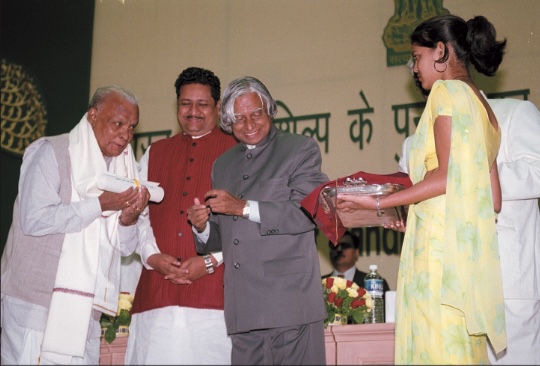By Rajiv Malik
Ten of India’s top craftsmen were honored November 16, 2002, by the President of India as Shilp Gurus, “Master Craftsmen,” which included one Craftswoman. Dr. A. P. J. Abdul Kalam Azad made the awards at the inauguration of the “Craft, Craftsperson and Sustainable Development” seminar held here in Delhi to highlight the importance of artistry for India. International specialists connected to the arts participated in the three-day event. Azad said, “I am very proud to see this initiative to revive craftsmanship in India.”
Among the Shilp Gurus were: J. Guappa Chetty, a painter in the Kalamkari style who also resurrected the production of high quality Indigo dye; Jivya Soma Mashe, a painter both on paper and on mud walls in the style of the Warli community of Maharashtra; Padam Shri Kirpal Singh Shekhawat, a painter of the Rajasthan school of Shekhawati who also resurrected the production of Blue Pottery for everyday use; C. Parameshwaracharya, whose family graced the court of the Vijayanagar Empire, an expert in stone, bronze and wood; 80-year-old Sonabai Rajwar, a housewife of the Sarguja community, Madhya Pradesh, who has won country-wide recognition for her skill in Rajwara clay sculpting; Vinayak Salvi, a weaver of the famed Patola silks; Nawang Tsering, master sculptor and painter of the Tibetan Mahayana Buddhist tradition of Ladakh; Jagdev Baghel, expert in brass casting; Jagdish Lal Raj Soni, master of the Thewa art form using etched gold on glass surfaces; and Dr. V. Ganapati Sthapati, India’s foremost temple architect.
Hinduism Today interviewed Sthapati after the event. He is the architect of Iraivan Temple, being built at Kauai Aadheenam, home of Hinduism Today, not to mention chief architect of the 133-foot high statue of Tiruvalluvar placed in the sea off Kanyakumari next to the Vivekananda Rock Memorial, Valluvar Kottam in Chennai and dozens of temples in India, America, Europe, Fiji, Australia and elsewhere.
In a wide-ranging discussion, he explained how he had fought for years for a higher status for the indigenous arts and crafts, as had his father before him. He was encouraged that India’s new president is a man of science (a physicist, key figure of India’s nuclear program), who would understand the value of the ancient arts and sciences. “If the government comes forward to give special attention to this scientific aspect of our culture, then it will grow fast. Otherwise, I will have to do this independently. The biggest threat to our stone-working tradition today is the scarcity and high price of high-quality granite. Many of the best stones are being used in road work and other purposes inferior to what we can do.”
“The success of the school of traditional architecture in Mahabalipuram is my greatest achievement,” he said, “because it has produced knowledgeable people. My father started the school in 1957, but then passed away. I was selected in an open competition to fill his post. I was principal to 1988. After my 54 years as a sthapati, our tradition is now found not only in the streets of Tamil Nadu, India, but in New York and Washington, D.C. You take it from me that this science is going to live for another ten thousand years.”
